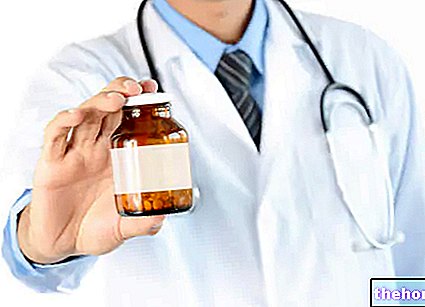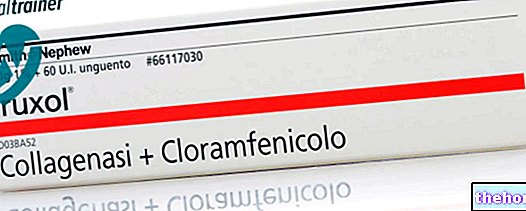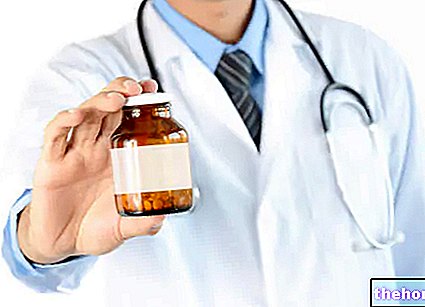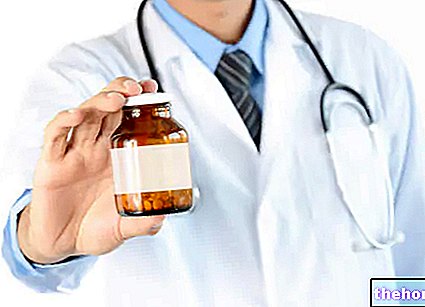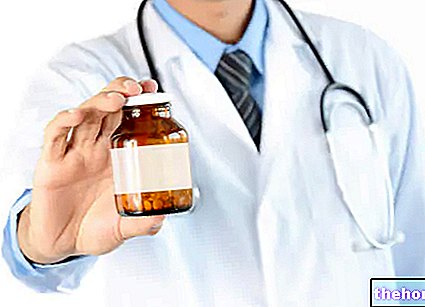Active ingredients: Spironolactone
ALDACTONE 25 mg hard capsules
ALDACTONE 100 mg coated tablets
Why is Aldactone used? What is it for?
PHARMACOTHERAPEUTIC CATEGORY
Diuretic, aldosterone antagonist.
THERAPEUTIC INDICATIONS
Treatment of primary or secondary aldosteronism and essential arterial hypertension, where other therapies have not been found to be sufficiently effective or tolerated.
Contraindications When Aldactone should not be used
Aldactone should not be used in:
- patients with hypersensitivity to the active substance or to any of the excipients;
- patients with impaired renal function and creatinine clearance less than 30 mL / min per 1.73 m2 of body surface area, acute renal failure or anuria;
- patients with hyperkalemia;
- patients with severe hyponatremia;
- patients with hypovolaemia or dehydration;
- during pregnancy;
- in women during lactation
Precautions for use What you need to know before taking Aldactone
Aldactone therapy should be carried out under careful medical supervision.
Particularly careful monitoring is necessary in the following cases:
- patients with severe hypotension;
- patients with impaired renal function (due to an increased risk of hyperkalaemia);
Aldactone therapy requires regular monitoring of serum sodium, potassium, creatinine and glucose levels.
Frequent monitoring of potassium is required in patients with impaired renal function and creatinine clearance below 60 mL / min per 1.73 m2 of body surface area, as well as in patients where Aldactone is administered with other drugs that may lead to increased potassium
Interactions Which drugs or foods can modify the effect of Aldactone
Tell your doctor or pharmacist if you have recently taken any other medicines, even those without a prescription
The absorption of spironolactone increases markedly with food intake.
Associations not recommended
If Aldactone is given in combination with potassium salts, drugs that reduce potassium excretion, non-steroidal anti-inflammatory drugs or ACE inhibitors, severe hyperkalaemia or an increase in potassium may occur.
To consider
Concomitant administration of non-steroidal anti-inflammatory drugs may reduce the effect of Aldactone.
Spironolactone and carbenoxolone can mutually impair their respective pharmacological activity. Licorice in high quantities acts in the same way as carbenoxolone.
Lithium salts: There is a risk of reducing its renal clearance, resulting in lithium toxicity.
Norepinephrine: There is a risk of reduced vascular responsiveness during local or general anesthesia.
Spironolactone can cause increases in serum digoxin levels.
A more pronounced drop in blood pressure can be expected with concomitant administration of Aldactone and hypotensive drugs.
Cholestyramine: Hyperkalaemia in the setting of hyperchloraemic metabolic acidosis has been reported in patients treated with Aldactone concomitantly with cholestyramine.
Warnings It is important to know that:
Important information about some of the ingredients
The tablets contain sucrose. If you have been told by your doctor that you have an intolerance to some sugars, contact your doctor before taking this medicinal product.
Spironolactone can cause vocal changes. This requires care in determining whether to initiate Aldactone therapy in patients for whom the voice plays an important role in work (eg actors, singers, teachers).
It can be presented:
- hyponatremia, which manifests itself with dry mouth, thirst, drowsiness, etc., especially if the drug is combined with other diuretics,
- increase in azotemia values, especially in the presence of renal insufficiency,
- hyperchloraemic acidosis usually with hyperkalaemia, especially in patients with decompensated liver cirrhosis.
For those who play sports:
The use of the drug without therapeutic necessity constitutes doping and can in any case determine positive anti-doping tests.
Pregnancy and Breastfeeding
Aldactone should not be taken during pregnancy. Animal studies have shown feminization of the genitals in male offspring. Anti-androgenic effects have been reported in humans.
Breastfeeding should be avoided during Aldactone therapy.
Effects on ability to drive and use machines
Due to various undesirable effects that may occur, the ability to concentrate and react may be impaired during therapy with Aldactone, thereby affecting the patient's ability to drive and use machines. This occurs particularly in the initial stages of therapy or after alcohol consumption.
Dosage and method of use How to use Aldactone: Dosage
In primary and secondary aldosteronism, the most commonly used daily dose ranges from 100 to 300 mg divided over 24 hours; in children this dose should be proportionally reduced based on body weight. Depending on the patient's condition and diuretic response, the dosage may be decreased or significantly increased, also in consideration of the good tolerability and the large safety margin of the drug.
In essential arterial hypertension, the daily dose, divided over 24 hours, varies from 200 to 400 mg in the first 2 - 3 weeks; at this dose, the maintenance dose may subsequently be replaced, to be adapted to the clinical response but generally contained within 25 - 100 mg per day.
Administration
Aldactone should be swallowed without chewing and with a sufficient amount of fluid (about 1/2 glass).
It is advisable to take the drug with breakfast and / or breakfast.
Overdose What to do if you have taken too much Aldactone
In case of accidental ingestion / intake of an excessive dose of ALDACTONE, notify your doctor immediately or go to the nearest hospital.
Possible signs of an overdose or intoxication include changes in the electrolyte balance and symptoms such as drowsiness and confusion.
There are no known specific antidotes to spironolactone. If the intake has taken place recently, attempts can be made to limit further absorption by removing the active ingredient (eg gastric lavage), or methods to reduce its absorption (eg activated charcoal).
Clinically relevant alterations in the water and electrolyte balance must be corrected. Corrective measures, aimed at the prevention and treatment of serious complications caused by these alterations (eg. Hyperkalemia) and other effects, may involve the need for careful general and specific monitoring and therapeutic measures (eg. To promote " elimination of potassium).
Side Effects What are the side effects of Aldactone
Like all medicines, this medicine can cause side effects, although not everybody gets them.
The frequency of the following adverse reactions is not known (frequency cannot be estimated from the available data)
Disorders of the blood and lymphatic system
Changes in the blood picture (eosinophilia, agranulocytosis).
Metabolism and nutrition disorders
Hyperkalaemia may develop during Aldactone therapy and the risk is particularly high in patients with impaired renal function. In the event of an irregular heart rate, muscle fatigue or weakness (e.g. in the legs) the possibility of a hyperkalaemia condition should be considered.
Aldactone can lead to hyponatremia (especially when associated with the ingestion of large amounts of fluids), hypovolaemia and dehydration and can contribute to the onset or worsening of hyperchloraemic metabolic acidosis.
Dizziness and leg cramps may also occur in the context of hypovolaemia, dehydration or hyperkalemia.
Various pathologies, other concomitant medications and the type of diet can play an important role in the possible development of electrolyte balance disturbances.
Alterations in the electrolyte balance must be corrected, particularly if significant.
Respiratory, thoracic and mediastinal disorders
Spironolactone can cause vocal changes in the form of hoarseness and lowering of the voice in women or increased pitch in men. In some patients, the vocal changes persist even after discontinuation of the drug.
Gastrointestinal disorders
Gastrointestinal symptoms such as nausea, vomiting or diarrhea. In isolated cases, hepatic enzyme elevations as well as gastric ulcers (including bleeding) may develop.
Skin and subcutaneous tissue disorders
Aldactone can trigger allergic or allergic-type skin reactions (including hives, itching). bullous pemphigoid, hirsutism.
Renal and urinary disorders
Increased urine output can cause or worsen complaints in patients with urinary flow obstruction.
Diseases of the reproductive system and breast
Due to its chemical similarity to sex hormones, spironolactone can make the nipples more sensitive to touch and cause mastodynia and breast enlargement. This effect is dose-dependent and occurs in both men and women. Menstrual irregularities (dose-dependent) may occasionally occur in women. Sexual potency may occasionally be impaired in men.
Reporting of side effects
If you get any side effects, talk to your doctor or pharmacist. This includes any possible side effects not listed in this leaflet. You can also report side effects directly via the Italian Medicines Agency, Website: https://www.aifa.gov.it/content/segnalazioni-reazioni-avverse By reporting side effects you can help provide more information about the safety of this medicine
Expiry and Retention
Expiry: see the expiry date indicated on the package.
CAUTION: DO NOT USE THIS MEDICINAL PRODUCT AFTER THE EXPIRY DATE STATED ON THE BOX. THE EXPIRY DATE REFERS TO THE LAST DAY OF THAT MONTH.
The expiry date indicated refers to the product in intact packaging, correctly stored.
Storage:
Aldactone 25 mg hard capsules: Do not store above 30 ° C
Aldactone 100 mg coated tablets: no special storage precautions
KEEP THE MEDICINAL PRODUCT OUT OF THE SIGHT AND REACH OF CHILDREN.
COMPOSITION
One hard capsule contains:
Active principle: spironolactone 25 mg.
Excipients: polyoxyethylene ethylene glycol, corn starch, talc, gelatin, erythrosine (E 127), indigo carmine (E 132), titanium dioxide (E 171).
One coated tablet contains:
Active principle: spironolactone 100 mg.
Excipients: carmellose sodium, maize starch, magnesium stearate, polyoxyethylene ethylene glycol, gelatin, sodium dioctyl sulfosuccinate, talc, light magnesium carbonate, titanium dioxide (E 171), kaolin, sucrose.
PHARMACEUTICAL FORMS AND CONTENT
"25 mg hard capsules": box of 16 capsules in blister packs.
"100 mg coated tablets": box of 10 tablets in blister
Source Package Leaflet: AIFA (Italian Medicines Agency). Content published in January 2016. The information present may not be up-to-date.
To have access to the most up-to-date version, it is advisable to access the AIFA (Italian Medicines Agency) website. Disclaimer and useful information.
01.0 NAME OF THE MEDICINAL PRODUCT
ALDACTONE
02.0 QUALITATIVE AND QUANTITATIVE COMPOSITION
One hard capsule contains:
Active principle: spironolactone 25 mg.
One coated tablet contains:
Active principle: spironolactone 100 mg.
For excipients, see 6.1.
03.0 PHARMACEUTICAL FORM
Hard Capsules - Coated Tablets.
04.0 CLINICAL INFORMATION
04.1 Therapeutic indications
Treatment of primary or secondary aldosteronism and essential arterial hypertension, where other therapies have not been found to be sufficiently effective or tolerated.
04.2 Posology and method of administration
In primary or secondary aldosteronism the most commonly used daily dose ranges from 100 to 300 mg divided over 24 hours; in children this dose should be proportionally reduced based on body weight. Depending on the patient's condition and diuretic response, the dosage it can be decreased or considerably increased also in consideration of the good tolerability and the large safety margin of the drug.
In "essential arterial hypertension, the daily dose, divided over 24 hours, varies from 200 mg to 400 mg in the first 2-3 weeks; this dose may subsequently be replaced by the maintenance dose, to be adapted to the clinical response but generally contained within 25 -100 mg per day.
Administration
Aldactone should be swallowed without chewing and with a sufficient amount of fluid (approximately ½ glass).
It is advisable to take the drug with breakfast and / or breakfast.
04.3 Contraindications
Aldactone should not be used in:
• patients with hypersensitivity to the active substance or to any of the excipients
• patients with impaired renal function and creatinine clearance less than 30 mL / min per 1.73 m2 of body surface area, acute renal failure or anuria
• patients with hyperkalaemia
• patients with severe hyponatremia
• patients with hypovolaemia or dehydration
• during pregnancy
• in women who are breastfeeding
04.4 Special warnings and appropriate precautions for use
Spironolactone can cause vocal changes. This requires care in determining whether to initiate Aldactone therapy in patients for whom the voice plays an important role in work (eg actors, singers, teachers).
Aldactone therapy should be carried out under careful medical supervision.
Particularly careful monitoring is required in the following cases:
• patients with severe hypotension
• patients with reduced kidney function (due to an increased risk of hyperkalaemia)
Aldactone therapy requires regular monitoring of serum sodium, potassium, creatinine and glucose levels.
Frequent monitoring of potassium is required in patients with impaired renal function and creatinine clearance below 60 mL / min per 1.73 m2 of body surface area, as well as in patients where Aldactone is administered with other drugs that may lead to increased potassium .
It can be presented:
- hyposodiema, which manifests itself with dry mouth, thirst, drowsiness, etc., especially if the drug is combined with other diuretics
- increase in azotemia values, especially in the presence of renal insufficiency,
- hyperchloraemic acidosis usually with hyperkalaemia, especially in patients with liver cirrhosis in decompensation.
The tablets contain sucrose and are therefore not suitable for people with hereditary fructose intolerance, glucose / galactose malabsorption syndrome or sucrase-isomaltase deficiency.
04.5 Interactions with other medicinal products and other forms of interaction
The absorption of spironolactone increases markedly with food intake.
Associations not recommended
If Aldactone is given in combination with potassium salts, drugs that reduce potassium excretion, non-steroidal anti-inflammatory drugs or ACE inhibitors, severe hyperkalaemia or an increase in potassium may occur.
To consider
Concomitant administration of non-steroidal anti-inflammatory drugs may reduce the effect of Aldactone.
Spironolactone and carbenoxolone can mutually impair their respective pharmacological activity. Licorice in high quantities acts in the same way as carbenoxolone.
Lithium salts: There is a risk of reducing its renal clearance, resulting in lithium toxicity
Norepinephrine: There is a risk of reduced vascular responsiveness during local or general anesthesia.
Spironolactone can cause increases in serum digoxin levels.
A more pronounced drop in blood pressure can be expected with concomitant administration of Aldactone and hypotensive drugs.
04.6 Pregnancy and lactation
Aldactone should not be taken during pregnancy.
Breastfeeding should be avoided during Aldactone therapy.
04.7 Effects on ability to drive and use machines
Due to various undesirable effects that may occur, the ability to concentrate and react may be impaired during therapy with Aldactone, thereby changing the patient's ability to drive or use machines. This occurs particularly in the initial stages of therapy or after alcohol consumption.
04.8 Undesirable effects
Hyperkalaemia may develop during Aldactone therapy and the risk is particularly high in patients with impaired renal function. In the event of an irregular heart rate, muscle fatigue or weakness (e.g. in the legs) the possibility of a hyperkalaemia condition should be considered.
Aldactone can lead to hyponatremia (especially when associated with the ingestion of large quantities of fluids), hypovolaemia and dehydration and can contribute to the onset or worsening of hyperchloraemic metabolic acidosis.
Various pathologies, other concomitant medications and the type of diet can play an important role in the possible development of electrolyte balance disturbances.
Alterations in the electrolyte balance must be corrected, particularly if significant.
Increased urine output can cause or worsen complaints in patients with urinary flow obstruction.
Due to its chemical similarity to sex hormones, spironolactone can make the nipples more sensitive to touch and cause mastodynia and breast enlargement. This effect is dose-dependent and occurs in both men and women. Menstrual irregularities (dose-dependent) and hirsutism may occasionally occur in women. Sexual potency may occasionally be impaired in men. Rarely, spironolactone can cause vocal changes in the form of hoarseness and lowering of voice in women or increased pitch in men. In some patients, the vocal changes persist even after discontinuation of the drug.
Gastrointestinal symptoms such as nausea, vomiting or diarrhea may occur. In isolated cases, hepatic enzyme elevations as well as gastric ulcers (including bleeding) may develop.
Aldactone can trigger allergic or allergic skin reactions (including hives) and changes in the blood picture (eosinophilia, agranulocytosis).
04.9 Overdose
Possible signs of an overdose or intoxication include changes in the electrolyte balance and symptoms such as drowsiness and confusion.
There are no known specific antidotes against spironolactone. If the intake has taken place recently, attempts can be made to limit further absorption through the removal of the active ingredient (eg gastric lavage), or methods to reduce its absorption (eg activated charcoal).
Clinically relevant changes in the water and electrolyte balance must be corrected. Corrective measures, aimed at the prevention and treatment of serious complications caused by such alterations (eg hyperkalemia) and other effects, may involve the need for careful general and specific monitoring and therapeutic measures (eg. To promote " elimination of potassium).
05.0 PHARMACOLOGICAL PROPERTIES
05.1 Pharmacodynamic properties
Pharmacotherapeutic group: diuretics, aldosterone antagonists.
ATC code: C03DA01.
Spironolactone, a specific antagonist of aldosterone, acts at the level of the distal renal tubule, thus blocking the increase in sodium and chlorine reabsorption and the increase in potassium excretion, normally induced by mineralocorticoids. With this mechanism, spironolactone exerts a diuretic effect in the edematous stages sustained by hyperaldosteronism, in which the sodium-potassium exchange altered by the excess of aldosterone is brought back to normal.
Aldactone must therefore be considered an effective drug for the control of edema from primary or secondary aldosteronism (such as that which occurs in cardiocirculatory decompensation, in liver cirrhosis, in nephrotic syndrome), especially if resistant to common diuretics. "Aldactone can be combined when you want to obtain an enhancement of effect, deriving from the different point of attack and the different modalities of action of the drugs, and the advantage of reducing the loss of potassium induced, to varying degrees, by traditional diuretics. . The property of Aldactone to avoid potassium losses is of particular importance in the treatment of cirrhosis with ascites, as hypokalemia can facilitate the onset of coma, and in digitalis therapy for the known increase in digitalis toxicity in the presence of hypokalemia.
In "essential arterial hypertension" Aldactone, through an "antagonist action against" aldosterone or other mineralocorticoid, exerts a notable antihypertensive action, especially in forms with low plasma renin levels. In cases of essential arterial hypertension concomitant with a diabetic or prediabetic state, as well as with uratic diathesis, Aldactone is also an advantageous alternative to common diuretics. The diuretic effect of spironolactone generally sets in gradually. The peak of the effect is reached about 2 - 3 days after the start of the therapy and the effect persists for about the same period after the discontinuation of the treatment.
05.2 Pharmacokinetic properties
Spironolactone is rapidly absorbed after oral administration (tmax 1-2 hours). After oral administration, spironolactone undergoes first pass metabolism and is metabolised to 7-alpha-thio-spironolactone, canrenone and canrenoate, 7-alpha-thiomethyl-spironolactone and 6-beta-hydroxy-7-alpha-thiomethyl-spironolactone. Maximum concentrations of these metabolites are reached after approximately 2 - 4 hours. The absolute bioavailability of canrenone following oral administration of spironolactone averages approximately 25% of the administered dose.
The first three metabolites mentioned above possess mineralocorticoid activity which corresponds to 26%, 68% and 33% respectively of that of the unchanged drug.
At dosages between 25 mg and 200 mg, there is an approximately linear correlation between the single dose of spironolactone and the plasma concentrations of canrenone, while higher doses produce relatively lower concentrations.
The plasma half-life of spironolactone is approximately 1.5 hours and that of canrenone is 9 to 24 hours.
Spironolactone is eliminated rapidly while its metabolites are eliminated more slowly. Elimination occurs mainly via the kidney and to a lesser extent via the biliary route.
Both spironolactone and canrenone bind 90% and more to plasma proteins (90% and 98% respectively).
The absorption of spironolactone is enhanced by the presence of food, leading to an increase in plasma concentrations of the parent drug and metabolites of approximately 50% - 100%.
Spironolactone and its metabolites cross the placental barrier.
Canrenone is secreted in breast milk.
05.3 Preclinical safety data
Chronic toxicity
The chronic and subchronic toxicity of spironolactone has been studied in various animal species. Only the rat study found signs of an "increased incidence of benign thyroid and testicular adenomas at high doses."
Mutagenesis and carcinogenesis
In animal studies, no carcinogenic or mutagenic effects have been shown even at extremely high doses of spironolactone. This finding can be explained by its metabolism which is different from that of potassium canrenoate. Spironolactone and its sulfur-containing metabolites block the biotransformation of canrenone to intermediate epoxides which are believed to be the cause of the tumorigenic effect of potassium canrenoate.
Reproductive toxicology
In rats, spironolactone causes feminization of male fetuses and this finding is attributed to the antiandrogenic effect of the drug. Studies in rats and mice have revealed no signs of teratogenic effects.
06.0 PHARMACEUTICAL INFORMATION
06.1 Excipients
Hard capsules
Polyoxyethylene glycol, talc, corn starch, erythrosine (E127), indigo carmine (E132), titanium dioxide (E171), gelatin.
Coated tablets
magnesium stearate, maize starch, carmellose sodium, gelatin, polyoxyethylene ethylene glycol, light magnesium carbonate, kaolin, talc, sodium dioctylsulfosuccinate, titanium dioxide (E171), sucrose.
06.2 Incompatibility
During therapy with Aldactone it is recommended to avoid the administration of potassium, either in the form of a drug or in a diet rich in potassium, unless a treatment with cortisone is practiced at the same time.
06.3 Period of validity
Aldactone 25 mg hard capsules: 5 years.
Aldactone 100 mg coated tablets: 3 years.
06.4 Special precautions for storage
Aldactone 25 mg hard capsules: Do not store above 30 ° C
Aldactone 100 mg coated tablets: no special storage precautions
06.5 Nature of the immediate packaging and contents of the package
"25 mg hard capsules and 16 capsules in blister packs.
"100 mg coated tablets 10 tablets in blister packs.
06.6 Instructions for use and handling
No special instructions.
07.0 MARKETING AUTHORIZATION HOLDER
sanofi-aventis S.p.A. - Viale L. Bodio, 37 / B - 20158 Milan
08.0 MARKETING AUTHORIZATION NUMBER
"25 mg hard capsules 16 capsules A.I.C.n. 019822028
"100 mg coated tablets 10 tablets A.I.C. n. 019822030
09.0 DATE OF FIRST AUTHORIZATION OR RENEWAL OF THE AUTHORIZATION
July 1962 / June 2010
10.0 DATE OF REVISION OF THE TEXT
February 2014

